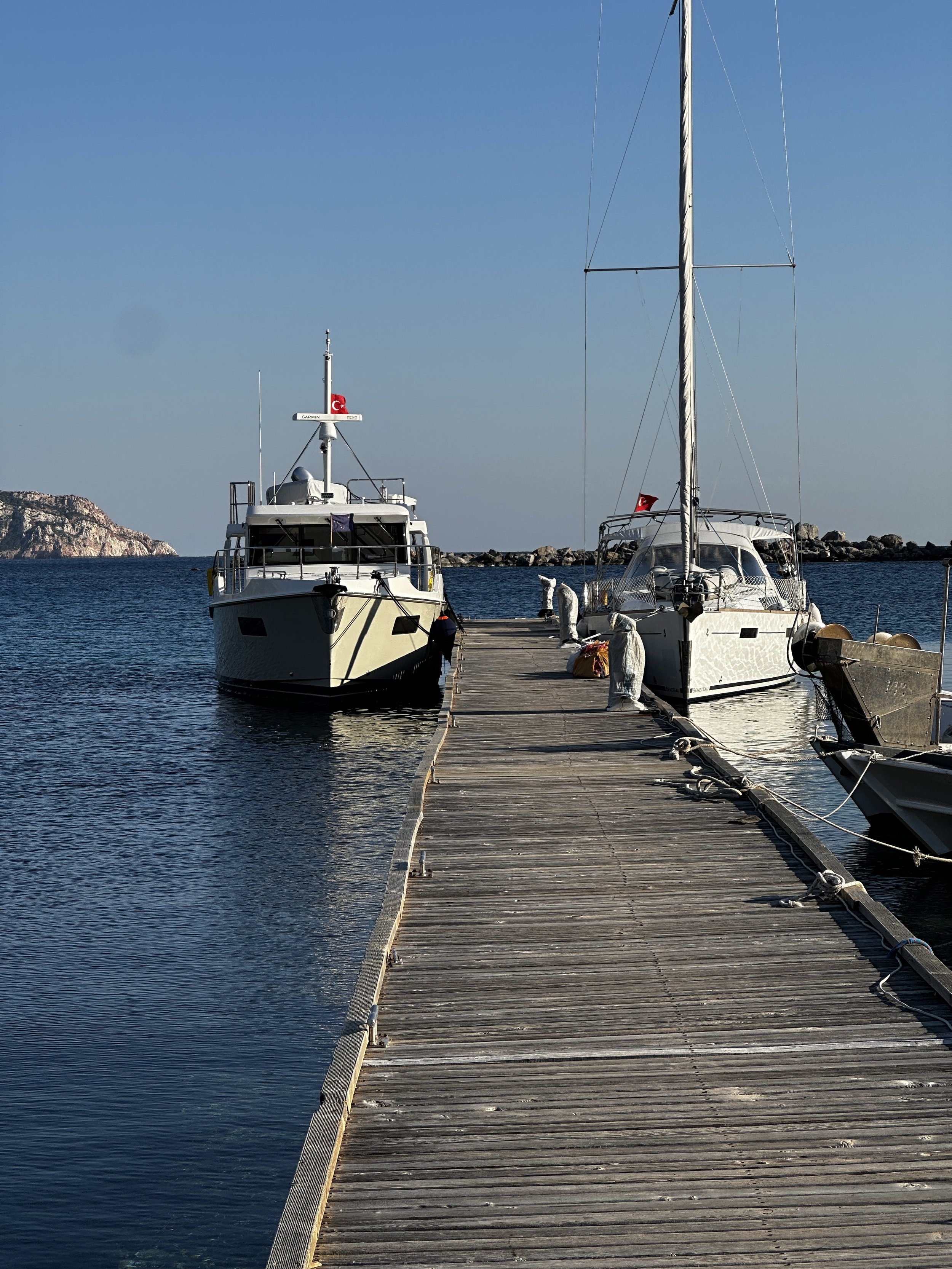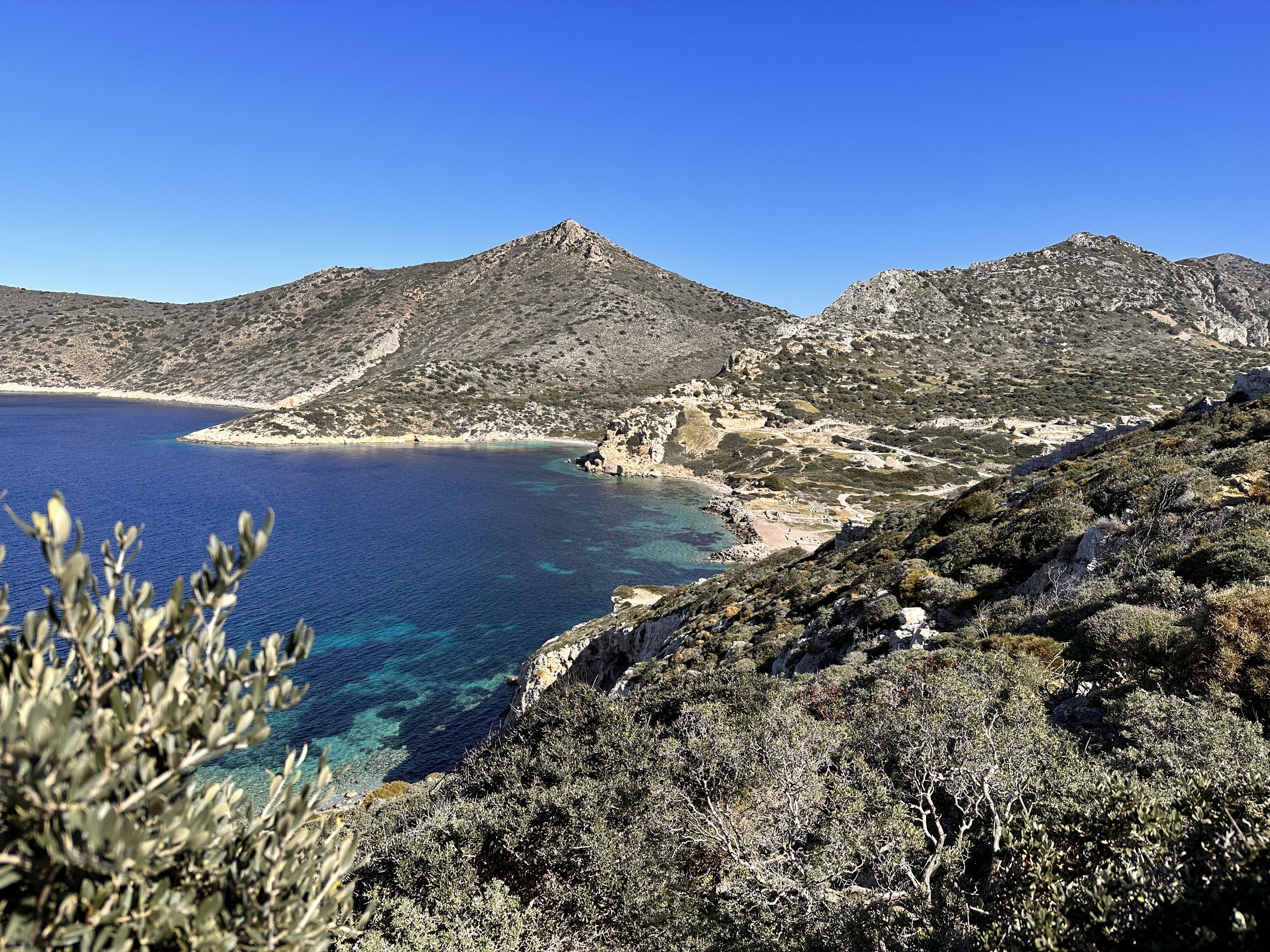Ordinary Magic
I’ve been home in Alaska for a couple of weeks now, reconnecting with all my friends, enjoying the sparkling light reflecting off the snow, soaking up the warmth of the winter sun and doing some cross country skiing. Today I found the beginnings of what was intended to be my last post before flying home - yet somehow I never finished it. So I’ll just leave it here for those of you interested in reading a somewhat outdated post...
We left Göcek and pointed our bow north. We had made arrangements to leave Meraki on land in a marina near Izmir and we had several days to meader our way there. I had reprovisioned the boat while Tom assisted the mechanics who did the minor repairs we’d scheduled. Our first night we found what might be my favorite anchorage to-date. Serçe is an anvil shaped bay with a narrow entrance, a long pointed northerly end and a broader, triangular southern end. The area is surrounded by super steep stoney mountains which plunge into the water. There were a few boats tied to a dock in the northern end so we headed to the south side. A small, abandoned stone building hides in an olive grove on a gravelly beach. The bay is small and we questioned if the scope needed for our anchor chain might put us on the rocky shore. After moving to a shallower area, and paying out less chain, we calculated our distance to the shoreline and knew we’d be fine. It was dead calm. Not a speck of wind. Total silence. I was in heaven!
Entering Serçe
The surrounding mountains were dotted with scrub and literally peppered with wild goats. These nimble-footed creatures can scale cliffs with over sixty-degree inclines and their antics delighted me and kept me entertained for hours. We played, practiced launching and retrieving the dinghy, explored along the edges of the shore, and rowed around in the crystalline turquoise water.








The next day we continued on. We needed a protected harbor to sit out an oncoming storm. We found ourselves tied up once again to a restaurant dock but this time in the bay at Knidos. Knidos is located at the end of the Datça Peninsula. The 2,600-year-old city of Knidos, also known as Cnidus, is an ancient Greek city, with magnificent structures, a port street lined with columns, an agora, two ancient theaters and two ports.
We had arrived early in the day so we explored the ruins that afternoon. Normally packed with tourists, on this February day the site was windswept, lonely and beautiful. Archaeologists date the city back to the first half of 2,000 BC. It was home to a respected medical school and physicians whose fame had spread throughout the ancient world. Like so many of the ancient sites we’d visited, there are occasional interpretive signs describing the purpose of particular structures or chunks of marble blocks strewn about. To be honest though, I was too taken with the scenery – both the natural setting and the layout of Knidos around it – to concentrate on the details.
Perched on a steep hillside Knidos provides dramatic views surrounded by the Mediterranean and Aegean seas. In fact, it is referred to as the 'gate of the Aegean' as it is at the intersection of the two. You’d think while living on a boat, that views of the ocean would not be so captivating. But as my sharp-witted daughter pointed out, when we are at sea we look at the land and when on land we look out at the sea!
The next day (my birthday) was warm and sunny and we decided to take a hike up the hillside. We could see a lighthouse perched on a cliff at the end of the point. It was perfect hiking weather and we followed what appeared to be a goat path around the bay and up to the top of the hillside. From there the full expanse of the Mediterranean spread out in front of us while behind us lay the aquamarine Aegean. Once again, from this spectacular overlook, we found ourselves marvelling at the view of the ocean. We wandered back down to Meraki where I took a dip, and we enjoyed sundowners on the back deck, followed by dinner and a rousing game of backgammon. A perfect way to celebrate a birthday!
























We stayed in Knidos a couple more days waiting for good weather. Another boat arrived and tied up opposite us on the dock to wait as well. The couple onboard spoke english to each other as she was Turkish and he was Romanian. It allowed us an opportunity to socialize as well so we shared a meal together at the restaurant swapping stories about culture, politics, cruising, passage planning and the everpresent winds and waves.
It was now Wednesday and we needed to get further north. We were running out of anchorages between us and the marina in Sığacık where we would be leaving Meraki. We needed to be there by Friday to avoid howling winds so we set out to find a place to overnight within one days travel of the marina. Our best option was Cukurcuk near Didim at the north-west end of the Gulf of Gulluk. It is a three-part bay surrounded by land that is flat and treeless. In the shallow east bay there is a fish farm and that section is closed to the public. There is also a small cove to the west and it looked to be a safe anchorage. We dropped the hook in 7.5 meters of water about midway between the two. There was a long gentle swell rolling in - not ideal but manageable.
The swells lay down around midnight and we slept well, pulling anchor at dawn the next morning. The seas were choppy when we set out, but our final voyage before lifting Meraki out of the water turned out to be pure magic! Within minutes of leaving the bay we found ourselves in a HUGE pod of striped dolphins. I would guess there were close to a hundred of them dancing around us. They were everywhere - I didn’t know where to look. Some were close to the boat and others farther ahead. It was as if we were all traveling together, headed to the same destination. There was a bunch on one side, then dozens more on the other. You could see them splashing far ahead of us while loads more swam under and around the boat. While one group happily played in the surf at our bow, still more threaded their way around the boat performing acrobatic leaps and aerial spins. These inquisitive, playful creatures seemed to be performing a complex choreography just for us. I cannot even begin to explain this extraordinary magic. Hard as we tried to photograph it, we ended up standing in our pajamas, mesmerized, quietly smiling and watching. The show lasted a solid 20 minutes. What a phenomenal way to start a day!
Just a few nautical miles further on we approached the Mycale Strait separating the Greek island of Samos from the coast of Turkey. It is the closest the two countries get to one another and at its narrowest point they are separated by only 1.6 km. We had 3.5 knots of current with us that morning and Meraki zipped through the channel faster than she’d ever gone.
Just north of the strait the seas flattened out and suddenly we were cruising on what felt like a pond. We passed huge tankers and large fish farms where they raise Sea Bass (Dicentrarchus labrax) and Sea Bream (Sparus aurata). Our route took us in and out of Greek waters and at one point we were approached by the Greek Coast Guard. We were flying the Turkish flag and we wondered, fleetingly, if we should have been changing it back and forth. Later as we passed back into Turkish waters, the Turkish Coast Guard passed by. Though we were approached - we were never stopped, so we continued on our way. Our final cruise was coming to a close and as we neared Teos Marina a class of young sailing students breezed by in a regatta - simply a marvel in moving beauty.





We spent a few days opening hatches and cleaning out lockers, emptying the fridge and freezer, and packing before Meraki was lifted onto the hard.
Our final day in Turkey we took a long 12 km hike over low hilly farmland into the ruins of this ancient city. Ongoing excavations are being conducted by the University of Ankara and more of the ruins continue to be unearthed. A flourishing seaport with two fine harbors in Greek and Roman times, Teos was known for its wines, theatre, and Temple of Dionysus.























What a terrific way to prepare for the 29 hours of travel which would begin the next morning.
Note: Photo captions do not appear if viewing on a mobile device.



